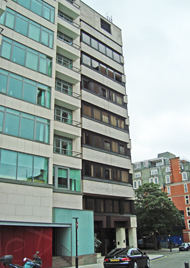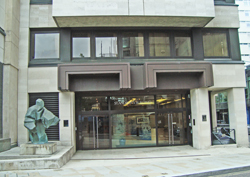General surgical
In 1911 the Australian surgeon (Sir) Douglas Andrew Shields (1876-1952) was asked by Mrs Catherine Fink, the widow of the financier Benjamin Fink (1847-1909), to attend her son Harold, who was gravely ill.
Although he had been unable to save her son, Mrs Fink bought a large mansion house at 17, Park Lane, and converted it into a private hospital for Shields, who then moved from Melbourne to London in 1912.
During WW1 Shields served with the British Expeditionary Force in France, and became Surgeon-in-Chief of the Australian Voluntary Hospital. His Hospital in Park Lane became the Hospital for Wounded Officers, a section of Queen Alexandra Military Hospital. It had 20 beds and was entirely financed by Mrs Fink. By February 1917 over 1,300 officers had been treated there.
After the war the Hospital became his private clinic with 25 beds for general surgical cases. His consulting rooms were located in Brick Street, behind the Hospital.
In 1919 Shields was knighted for his wartime services.
Although he lacked a senior surgical degree and had not been appointed to the honorary consulting staff of a London hospital, his practice flourished, especially among the aristocracy, the famous and the rich. His surgical skills were well recognised and among his distinguished patients were the Grand Duke Alexander Mikhailovich of Russia, Ramsay MacDonald, John Galsworthy, Sir James Barrie, Dame Nellie Melba and Sir Donald Bradman.By 1929 an Intermediate Hospital, an annexe clinic to the Hospital, had been established for middle class patients who could not afford ordinary full surgical expenses, but wanted to avoid any semblance of charity "which would be distasteful to such". Post-surgical patients would be attended by their own general practitioners. The weekly fee for a room at the annexe was 3 guineas (£3.15), the surgeon's fee was £26 5s (£26.25), assistant surgeon's 2 gns (£2.10) and the anaesthetist's 3 gns (£3.15). A charge of one guinea (£1.05) was made for the use of the operating theatre and dressings. Patients were expected to stay for a maximum of three weeks, and the whole episode would cost from £42 onwards. In 1930 the weekly fee had been reduced to 2 guineas (£2.10), the surgeon's fee to 10 gns (£10.50). The charges for the anaesthetist and for the operating theatre remained the same.
The Hospital closed around 1935.Present status (August 2010)
An office block, St Andrew's House, now occupies the site.


St Andrew's House, 17 Park Lane.

The main entrance.
(Author unstated) 1917 List of the various hospitals treating military cases in the United Kingdom. London, H.M.S.O.
http://trove.nla.gov
www.bmj.com
Return to home page